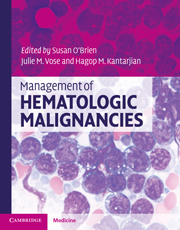Book contents
- Frontmatter
- Contents
- List of contributors
- 1 Molecular pathology of leukemia
- 2 Management of acute myeloid leukemia
- 3 Treatment of acute lymphoblastic leukemia (ALL) in adults
- 4 Chronic myeloid leukemia
- 5 Chronic lymphocytic leukemia/small lymphocytic lymphoma
- 6 Myelodysplastic syndromes (MDS)
- 7 Hairy cell leukemia
- 8 Acute promyelocytic leukemia: pathophysiology and clinical results update
- 9 Myeloproliferative neoplasms
- 10 Monoclonal gammopathy of undetermined significance, smoldering multiple myeloma, and multiple myeloma
- 11 Amyloidosis and other rare plasma cell dyscrasias
- 12 Waldenstrom's macroglobulinemia/lymphoplasmacytic lymphoma
- 13 WHO classification of lymphomas
- 14 Molecular pathology of lymphoma
- 15 International staging and response criteria for lymphomas
- 16 Treatment approach to diffuse large B-cell lymphomas
- 17 Mantle cell lymphoma
- 18 Follicular lymphomas
- 19 Hodgkin lymphoma: epidemiology, diagnosis, and treatment
- 20 Treatment approaches to MALT/marginal zone lymphoma
- 21 Peripheral T-cell lymphomas
- 22 Mycosis fungoides and Sézary syndrome
- 23 Central nervous system lymphoma
- 24 HIV-related lymphomas
- 25 Lymphoblastic lymphoma
- 26 Burkitt lymphoma
- Index
- References
13 - WHO classification of lymphomas
Published online by Cambridge University Press: 10 January 2011
- Frontmatter
- Contents
- List of contributors
- 1 Molecular pathology of leukemia
- 2 Management of acute myeloid leukemia
- 3 Treatment of acute lymphoblastic leukemia (ALL) in adults
- 4 Chronic myeloid leukemia
- 5 Chronic lymphocytic leukemia/small lymphocytic lymphoma
- 6 Myelodysplastic syndromes (MDS)
- 7 Hairy cell leukemia
- 8 Acute promyelocytic leukemia: pathophysiology and clinical results update
- 9 Myeloproliferative neoplasms
- 10 Monoclonal gammopathy of undetermined significance, smoldering multiple myeloma, and multiple myeloma
- 11 Amyloidosis and other rare plasma cell dyscrasias
- 12 Waldenstrom's macroglobulinemia/lymphoplasmacytic lymphoma
- 13 WHO classification of lymphomas
- 14 Molecular pathology of lymphoma
- 15 International staging and response criteria for lymphomas
- 16 Treatment approach to diffuse large B-cell lymphomas
- 17 Mantle cell lymphoma
- 18 Follicular lymphomas
- 19 Hodgkin lymphoma: epidemiology, diagnosis, and treatment
- 20 Treatment approaches to MALT/marginal zone lymphoma
- 21 Peripheral T-cell lymphomas
- 22 Mycosis fungoides and Sézary syndrome
- 23 Central nervous system lymphoma
- 24 HIV-related lymphomas
- 25 Lymphoblastic lymphoma
- 26 Burkitt lymphoma
- Index
- References
Summary
Introduction
The latest fourth edition of the World Health Organization (WHO) classification of tumors of hematopoietic and lymphoid tissues (WHO classification) was published in 2008. The current and the previous (2001) editions of the WHO classification adopt the guiding principles of the widely accepted Revised European–American Classification of Lymphoid Neoplasms (REAL) classification published in 1994. Both the REAL and the WHO classifications aim at defining distinct disease entities that are both recognizable by pathologists and are meaningful to the clinicians. All available information from morphologic, immunophenotypic, genetic, and clinical assessments was utilized to define non-overlapping disease entities. Additionally, the complexity of the field necessitated the recruitment of a larger number of expert pathologists from around the world, and the inclusion of input from the clinicians in the development of the WHO classification. Broad agreement among the pathologists was required, even at the expense of compromise, which was considered vital for wide acceptance of the WHO classification.
Essential elements of the WHO classification
The WHO classification takes into account a combination of clinical, morphologic, immunophenotypic, and genetic information in recognizing distinct lymphoma entities, although the weight of each of these four parameters varies. Indeed, there is no ‘gold standard’ among these four features when defining individual entities.
Morphology
Morphologic features remain the foundation in the WHO classification and in day-to-day lymphoma diagnosis. Some disease entities, like the various subtypes of Hodgkin lymphomas (HLs), are still defined and diagnosed on morphologic grounds, with support from immunophenotypic results.
- Type
- Chapter
- Information
- Management of Hematologic Malignancies , pp. 228 - 256Publisher: Cambridge University PressPrint publication year: 2010



